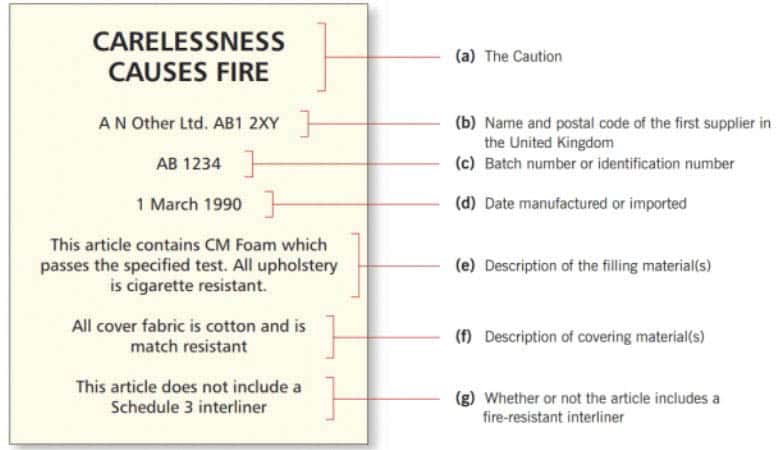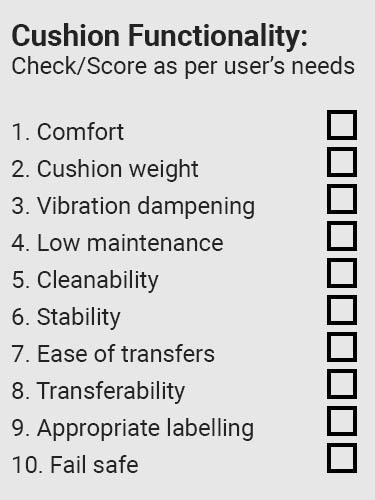Let’s get it clear: What makes a good cushion 2 – Functionality
This is the second article in a series which aims to start getting people thinking more about what goes into a cushion that makes it ‘good’ for one person, but not for another. In the first article, we identified the three key elements around which a cushion can be assessed – functionality, tissue integrity, and posture management. This article unpicks aspects around functionality.
By Dr Barend ter Haar
For the clinician, tissue integrity and positioning elements of a cushion come at the top of the list, while for the user, once these aspects have been covered, functionality comes top of their list, and can make the difference as to whether the cushion will be used, or just left on the shelf.
Comfort
Comfort is subjective. Barbara Crane, in the US, interviewing wheelchair users as the background for her PhD thesis, established that comfort was the most important element to users¹. The subjectivity behind comfort is why, in Switzerland, a clinician will prescribe a choice of three cushions, each of
which would be suitable for the user’s clinical needs, and the user then tries and selects which cushion they prefer.
 Cushion weight
Cushion weight
The weight of the cushion should be a crucial part of the decision process. If the user will be moving the cushion from one site to another, how easy is it for that person to lift and move it? If the user is acquiring a manual wheelchair, then every extra gram that the cushion weighs will equate to the extra effort that will be needed by the user or carer to move the chair.
Minimising fatigue
Vibrations coming up through the wheels and the seat add to the levels of a user’s fatigue when propelling a manual wheelchair. A study from the University of Pittsburgh compared four different cushion materials and reported that air-foam cushions dampened vibrations better than foam, air, or gel cushions², so the materials that the cushion is made from make a difference to the user’s rate of fatiguing.
Cushion self-sufficiency
The clinician is likely to get better compliance from users and carers when the amount of required day-to-day adjustment of their cushion is minimal. The importance and amount of daily user/carer cushion – interaction will be dictated by how critical it is for adjustments to be made for the cushion to continue to be clinically effective, so ideally select a cushion where possible that needs minimal day-to-day set-up interaction.
Maintenance and durability
Although we expect elements such as moisture, temperature, and sunlight to be the fastest source of ageing cushions, it is not these elements, but instead, the faecal bacteria that are released with flatulence, that has been found to be the biggest ageing element for cushions. Thus it is ideal
that the cushion and its cover can be readily cleaned and disinfected.
Under CE marking regulations for Instructions for Use, cushions are required to be supplied with instructions for approved methods of cleaning and disinfection.
Just as we might have more socks than shoes, mainly because it is what’s closer to the skin that needs washing most frequently, it is recommended that we have at least two covers for each cushion, so that while one cover is in the wash, the cushion can still be used with the other cover.
Enablement of day-to-day activities
The needs of the user to carry out their normal daily activities should be taken into consideration when selecting a suitable cushion. If the user needs to reach away from their wheelchair to carry out their daily activities, then the stability of the cushion to permit this is important.
There is a new International Standard (ISO 16840-13) being prepared to assess the lateral stability of one cushion as compared with another.
Another area for consideration relates to transfers. The smoother the cover, the easier it is to transfer.
Likewise, the less pre-contoured shape there is to the cushion, the easier it is to slide off it. This has to be balanced with the value of the contouring for posture management needs.
If the one cushion is to be used in different applications, how easy is it to be taken from one device to another – is there a handle? How strong are the hook-and-loop attachments?
Appropriate labelling is also valuable, particularly to aid inexperienced carers.
Simple indications of top and front are often needed to ensure the correct part of the cushion is interfacing with the relevant parts of the user’s body. Simple washing instructions should be supplied. UK furnishing flammability regulations require certain warning and related labelling for cushions (Fig. 1).

Fail-safe
A final, but possibly the most important aspect: how important is it and how likely is it for the user that the cushion, if it fails, fails safely?
Different materials each have their own level of risk. Foam over time will tend to develop a ‘set’ or the cells break down, and thus, the development of a failure to give optimal immersion to redistribute pressure forces is a slow (indiscernible) process.
At the other end of the scale, whereas an air cushion provides excellent immersion, a puncture immediately leaves the user at risk of tissue injury. If a gel cushion leaks, or the gel gets displaced, then what is in place under the gel becomes critical for continued protection of the skin.
In Conclusion
There are many elements that should be taken into account when selecting what might the most suitable cushion for an individual that go well beyond the immediate clinical needs of tissue integrity and posture management. This article provides a number of the relevant items under the functionality heading.
References
- Crane, et al (2004) Development of a Consumer-Driven Wheelchair Seating Discomfort Assessment Tool (WcS-DAT). Intl J Rehab Res 27: 85-90
- DiGiovine, C.P. et al (2000) Analysis of Vibration and Comparison of Four Wheelchair Cushions During Manual Wheelchair Propulsion Proc RESNA, 429-431
Further items can be found at www.beshealthcare.net. If you are interested in receiving further information on the topic, please contact barend@beshealthcare.net.
Dr Barend ter Haar has been involved in seating and mobility for over 30 years, including lecturing internationally and developing international seating standards.
Click to read more from the ‘Let’s get it clear’ series from Dr Barend ter Haar
https://thiis.co.uk/lets-get-it-clear-what-makes-a-good-cushion-2-functionality/https://thiis.co.uk/wp-content/uploads/2020/09/Lets-get-it-clear-cushion.jpghttps://thiis.co.uk/wp-content/uploads/2020/09/Lets-get-it-clear-cushion-150x150.jpgAnalysis & InsightsLet's Get It ClearNewsroomAssessment,clinician,comfort,cushion weight,cushions,durability,fatigue,functionality,posture management,tissue integrityThis is the second article in a series which aims to start getting people thinking more about what goes into a cushion that makes it ‘good’ for one person, but not for another. In the first article, we identified the three key elements around which a cushion can be...Calvin BarnettCalvin Barnettcalvin.barnett@bhta.comAuthorTHIIS Magazine


 Cushion weight
Cushion weight